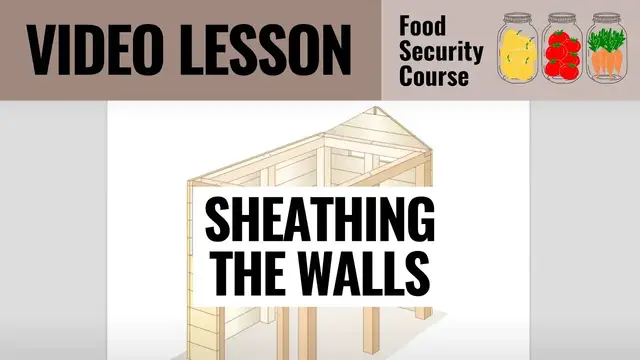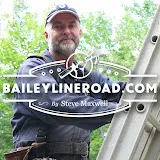0:00
In this video I want to give you some tips about sheathing the walls of your
0:06
smokehouse. Now I've spoken in other parts of the course about my
0:11
preference for using one and a half inch thick solid wood for wall and roof
0:17
sheathing. It's strong and solid and it hides fasteners and it doesn't have urea formaldehyde glue in it like sheet materials do, so it's my
0:29
preference. Now I mentioned also in other spots in the course that I feel
0:38
perfectly fine using current modern-day pressure treated lumber for these boards, certainly down at the bottom, if not the whole way up. Now that's because
0:52
nowadays the pressure treating chemicals are copper based and I don't think
0:57
there's any issue with toxicity, in my opinion, in a situation like this. You
1:02
may feel differently, you might want to use cedar, but if you are using some sort
1:09
of pressure treated material, this bottom course is going to be in full contact
1:14
with the soil. In fact, you're going to be building up a little bit of soil inside
1:19
here to make a raised floor. There's going to be some splashing from rain on
1:24
the outside, so if you want to be very diligent, I mean this is my
1:29
recommendation, you'd go with what they call a pressure treated lumber here on
1:35
the bottom course that's made for pressure treated wood foundations. Now believe it or not, in many parts of the world you can build a foundation, an
1:45
underground foundation, out of wood using the right kind of pressure treated
1:49
lumber. It never rots, essentially, they just treat it so well that it just
1:55
doesn't rot, ever, even in full contact. So the bottom course, you might want to
2:02
consider that material there if you're building for the long haul, like I always
2:06
do. Another thing to pay attention to here is to start these bottom courses
2:13
especially, to start them off so they're level, because they're going to set the
2:17
stage for everything else that goes higher. Even still, put a level on your
2:22
boards, say just before you install the third or fourth course, because even if
2:29
you started the first course level, it's conceivable you'll start getting out of
2:33
level eventually, and you can steer it back a bit over the next few courses if
2:37
you are out of whack. So check that. Now also, when you're cutting boards to
2:43
length, you've got long planks and you need to cut boards, say for these side
2:47
pieces or the back or these little pieces on either side of the door. When
2:52
you're cutting lumber out of a plank, always pay attention to the quality of
2:57
wood at what will be the end of the parts. So in this case, what's the wood
3:03
like here? What's the wood like here? And when I say what's the wood like, I mean
3:09
is it clear or does it have some knots in it or something? You know, knots might
3:13
look nice, but they're also structurally unstable and you can cause the board to split if there's a knot here and you happen to drive a screw or
3:24
nail through it. So position your boards so that any knots and swirly grain and
3:30
defects and things are away from the end points as well, at least. If there's
3:36
one that lands on this mid post here, then that's no big deal, but
3:41
the ends you do have to pay attention to and best practices dictate that you try
3:48
to make that as clear as possible. Now, should you use screws or nails to
3:53
fasten these boards? Well, either will work. I think in a case like this, I would
4:00
use, if I could, nails driven with an air nailer or some sort of
4:06
hoseless power nailer. That would work fine. My policy is always to use
4:12
galvanized fasteners, even when, strictly speaking, I don't need to. Like, for
4:18
instance, you could use regular plain un-galvanized fasteners for these boards and presumably you're going to be covering the outside with cedar shingles
4:27
to give it some extra weather protection. So technically those nails shouldn't get
4:31
wet, but my feeling is, you know, the added expense is minuscule and what
4:39
happens if, you know, if one day, a hundred years from now, someone comes along and
4:44
wants to refurbish this old forgotten smokehouse and the cedar shingles are
4:49
all worn out and falling off and the roof boards have been exposed to the
4:54
weather for the last 25 years, who knows? Your choice of rust resistant, rust
5:01
proof galvanized fasteners could be the difference between being able to refurbish this or not. I mean, regular plain fasteners might be all rusted
5:12
out and, you know, why not do the future a little bit of a favor? Spend a few extra
5:17
pennies on fasteners, always on fasteners that resist corrosion. I don't see any
5:24
reason not to, really. So one other thing, this gable treatment here, these are
5:32
thick boards and they are going to fasten to the face of rafters. There
5:38
will be, in the real smokehouse, there would be a rafter here and a rafter here
5:44
and that's what secures the end of these roof boards. Because you've made it with thick material, you don't need any more backing other than that. It's strong
5:51
enough to be self-supporting. However, install these boards after you have installed the rafters and the reason for that is because the rafters will
6:05
give you a guide. So you put the rafter there, the rafters in place, it's nailed
6:09
down, you lay down your board, you mark a pencil line here following the rafter
6:14
here following that rafter, you take it down, you cut it, you put it back, nail it
6:19
to the rafter, continue on up and do the next one. That's the most efficient way
6:24
to do this and you'll find that you get a nice fit and the roof boards will go
6:30
on properly without riding on any extra wood that might be present here from the



